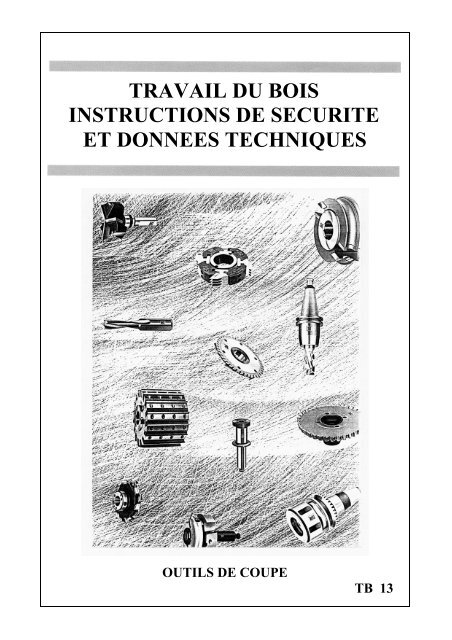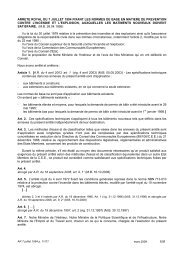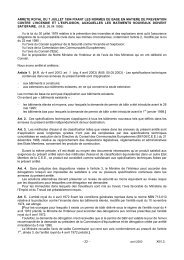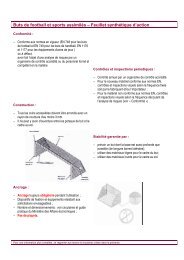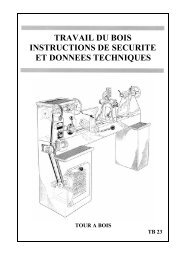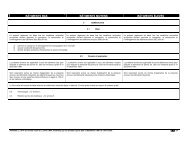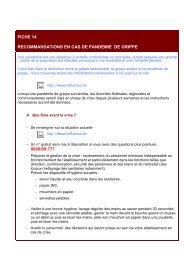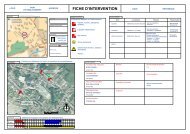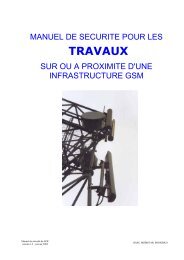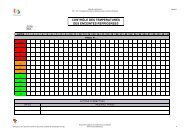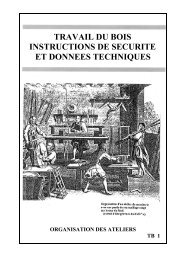travail du bois instructions de securite et donnees techniques
travail du bois instructions de securite et donnees techniques
travail du bois instructions de securite et donnees techniques
You also want an ePaper? Increase the reach of your titles
YUMPU automatically turns print PDFs into web optimized ePapers that Google loves.
TRAVAIL DU BOIS<br />
INSTRUCTIONS DE SECURITE<br />
ET DONNEES TECHNIQUES<br />
OUTILS DE COUPE<br />
TB 13
SOMMAIRE TB 13<br />
Table <strong>de</strong>s matières détaillées……………...... 01 à 03<br />
Objectifs ……………………………………. 1<br />
Caractéristiques générales.………………….. 2<br />
Caractéristiques spécifiques………………… 7<br />
Façonnage…………………………………… 24<br />
- Consignes générales……………………... 24<br />
- Constatations d’irrégularités...………….. 25<br />
Instructions <strong>de</strong> sécurité……………………… 26<br />
- Mesures générales <strong>de</strong> prévention………… 26<br />
- Mesures spécifiques..…………………….. 26<br />
Test………………………………………….. 27<br />
Info. complémentaires / outils <strong>de</strong> coupe……... 28<br />
Les références aux articles <strong>de</strong> loi <strong>et</strong> autre documents officiels sont données à titre informatif <strong>et</strong><br />
ne peuvent en aucun cas engager ni les auteurs <strong>de</strong>s fiches ni le C.F.B.<br />
Lors <strong>de</strong> la mise en application <strong>de</strong>s informations fournies, il est conseillé aux lecteurs <strong>de</strong> faire<br />
appel à <strong>de</strong>s organismes officiels afin <strong>de</strong> connaître la législation en vigueur.<br />
© Centre <strong>de</strong> Formation Bois, Allée Hof ter Vleest 3, 1070 Bruxelles (voir TB 00).<br />
Nouvelle édition revue, complétée <strong>et</strong> actualisée (2 ème éd. 2002)
OBJECTIFS<br />
TABLE DES MATIERES TB 13-01<br />
Objectifs cognitifs 13 - 1<br />
Objectifs psychomoteurs 13 - 1<br />
Objectifs affectifs 13 - 1<br />
CARACTERISTIQUES GENERALES<br />
Sens <strong>de</strong> rotation 13 - 2<br />
Mo<strong>de</strong> <strong>de</strong> <strong>travail</strong> : - par au-<strong>de</strong>ssus 13 - 3<br />
- par en <strong>de</strong>ssous 13 - 3<br />
- en plein <strong>bois</strong> 13 - 3<br />
- en opposition 13 - 3<br />
- en avalant 13 - 3<br />
- directions d’usinage 13 - 4<br />
- vitesses <strong>de</strong> coupe conseillées 13 - 4<br />
- nature <strong>de</strong>s matériaux <strong>de</strong> coupe 13 - 4<br />
Dénomination <strong>de</strong>s angles caractéristiques<br />
A. Angles communs à tous les types d’outils 13 - 5<br />
B. Angles propres à certains types d’outils. 13 - 5<br />
CARACTERISTIQUES SPECIFIQUES<br />
1. Outils <strong>de</strong> sciage<br />
1.1 Lame pour scie à ruban : 13 - 6<br />
a) <strong>de</strong>scription 13 - 6<br />
b) types <strong>de</strong> <strong>de</strong>ntures 13 - 6<br />
c) spécifications à la comman<strong>de</strong> 13 - 6<br />
1.2. Lame pour scie circulaire : 13 - 7<br />
a) <strong>de</strong>scription 13 - 7<br />
b) types <strong>de</strong> <strong>de</strong>ntures à plaqu<strong>et</strong>tes rapportées 13 - 7 / 8<br />
c) spécifications à la comman<strong>de</strong> 13 - 8<br />
2. Outils <strong>de</strong> fraisage<br />
a) Description 13 - 9<br />
b) Types :<br />
b.1. fraise monobloc 13 - 9<br />
b.2. fraise monobloc à plaqu<strong>et</strong>tes rapportées 13 - 10<br />
b.3. fraise à plaqu<strong>et</strong>tes interchangeables (à j<strong>et</strong>er) 13 - 10<br />
b.4. porte-outils à profiler 13 - 10<br />
b.5. fraises empilées 13 - 10
TABLE DES MATIERES TB 13-02<br />
b.6. porte-outils <strong>de</strong> rabotage 13 - 11<br />
6.1. avec couteaux affûtables 13 - 11<br />
6.2. avec couteaux non affûtables (à j<strong>et</strong>er) 13 - 11<br />
6.3. avec couteaux autoblocants 13 - 11<br />
6.4. arbre à couteaux hélicoïdaux<br />
<strong>et</strong> porte-outils à système mo<strong>du</strong>laire 13 - 12<br />
c) Spécifications à la comman<strong>de</strong> 13 - 12<br />
d) Usinage en sécurité :<br />
d.1.diagramme <strong>de</strong>s vitesses <strong>de</strong> rotation 13 - 13<br />
d.2.diagramme <strong>de</strong>s vitesse d’avance 13 - 14<br />
d.3.état <strong>de</strong> surface 13 - 15<br />
3. Outils <strong>de</strong> perçage : 1 axe<br />
a) Description 13 - 16<br />
b) Types :<br />
b.1. mèche universelle 13 - 16<br />
b.2. mèche à angle <strong>de</strong> pointe 13 - 16<br />
b.3. mèche étagée 13 - 16<br />
b.4. mèche à pointe <strong>de</strong> centrage <strong>et</strong> araseurs 13 - 17<br />
b.5. mèche à bouchons 13 - 17<br />
b.6. mèche à hélice unique (LEWIN) 13 - 17<br />
b.7. fraisoirs 13 - 17<br />
c) Spécifications à la comman<strong>de</strong> 13 - 17<br />
4. Outils <strong>de</strong> défonçage : 2 ou 3 axes<br />
a) Description 13 - 18<br />
b) Types :<br />
b.1. mèches à mortaiser 13 - 19<br />
b.2. fraises à défoncer à coupe droite 13 - 19<br />
b.3. fraises à défoncer à coupe hélicoïdale 13 - 19<br />
b.4. fraises à profiler 13 - 19<br />
b.5. fraises porte-outils 13 - 19<br />
b.6. système universel <strong>de</strong> fraisage 13 - 19<br />
c) Spécifications à la comman<strong>de</strong> 13 - 20
TABLE DES MATIERES TB 13-03<br />
5. Chaîne <strong>de</strong> mortaisage<br />
a) Description 13 - 21<br />
b) Type 13 - 21<br />
c) Spécifications à la comman<strong>de</strong> 13 – 21<br />
6. Bédane <strong>de</strong> mortaisage<br />
a) Description 13 - 22 / 23<br />
b) Types 13 - 23<br />
b.1. monobloc<br />
b.2. à plaqu<strong>et</strong>tes rapportées<br />
b.3. porte-outils<br />
c) Spécifications à la comman<strong>de</strong> 13 - 23<br />
FACONNAGE<br />
1. Consignes générales<br />
a) Propre à l’outil 13 - 24<br />
b) Propre à la machine 13 - 24<br />
2. Constatations d’irrégularités<br />
- anomalies – causes 13 - 25<br />
INSTRUCTIONS DE SECURITE<br />
Mesures générales <strong>de</strong> prévention 13 -26<br />
Mesures spécifiques<br />
Dangers - prévention - moyens 13 - 26<br />
TEST 13 - 27<br />
INFO. COMPLEMENTAIRES / OUTILS DE COUPE 13 - 28
OBJECTIFS COGNITIFS<br />
OBJECTIFS TB 13-1<br />
1. DETERMINER le sens <strong>de</strong> rotation d’un outil <strong>de</strong> coupe.<br />
2. DIFFERENCIER un outil <strong>de</strong> coupe <strong>travail</strong>lant par au-<strong>de</strong>ssus ou par en <strong>de</strong>ssous.<br />
3. DIFFERENCIER le <strong>travail</strong> en opposition <strong>du</strong> <strong>travail</strong> en avalant.<br />
4. DEFINIR les directions d’usinage.<br />
5. NOMMER les matériaux composant les outils <strong>de</strong> coupe.<br />
6. IDENTIFIER les angles caractéristiques <strong>de</strong>s outils <strong>de</strong> coupe.<br />
7. DECRIRE un outil <strong>de</strong> coupe.<br />
8. ENUMERER les spécifications <strong>de</strong> comman<strong>de</strong> d’un outil <strong>de</strong> coupe.<br />
9. DIFFERENCIER les outils <strong>de</strong> coupe.<br />
10. EXPLIQUER l’inci<strong>de</strong>nce <strong>de</strong> certains outils <strong>de</strong> coupe sur la sécurité auditive.<br />
11. COMPULSER un tableau à trois entrées.<br />
12. EXPLIQUER les limites <strong>de</strong> vitesse <strong>de</strong> coupe en fonction <strong>de</strong> la sécurité.<br />
13. JUSTIFIER l’inci<strong>de</strong>nce <strong>du</strong> type d’outil sur la vitesse <strong>de</strong> coupe.<br />
14. PROUVER l’inci<strong>de</strong>nce <strong>du</strong> diamètre <strong>de</strong> l’outil sur la vitesse <strong>de</strong> coupe.<br />
15. COMPRENDRE l’inci<strong>de</strong>nce <strong>de</strong> la vitesse <strong>de</strong> rotation sur la vitesse <strong>de</strong> coupe.<br />
16. EXPLIQUER l’inci<strong>de</strong>nce <strong>de</strong> la nature <strong>du</strong> matériau à usiner <strong>et</strong> <strong>de</strong> la qualité <strong>de</strong> l’outil<br />
sur la vitesse <strong>de</strong> coupe.<br />
17. CHOISIR une vitesse <strong>de</strong> rotation en tenant compte d’un type d’outil, <strong>de</strong> son diamètre<br />
<strong>et</strong> <strong>du</strong> matériau à usiner.<br />
18. PROUVER la nécessité <strong>de</strong> l’équidistance <strong>de</strong>s tranchants <strong>du</strong> centre <strong>du</strong> porte-outils.<br />
19. DETERMINER l’outil capable d’effectuer un <strong>travail</strong> déterminé.<br />
OBJECTIFS PSYCHOMOTEURS<br />
1. CONTROLER l’état d’utilisation <strong>de</strong>s outils <strong>de</strong> coupe.<br />
2. MAINTENIR les outils <strong>de</strong> coupe en état <strong>de</strong> fonctionnement.<br />
3. RANGER les outils <strong>de</strong> coupe (par famille).<br />
4. MONTER un outil <strong>de</strong> coupe en toute sécurité.<br />
5. REGLER la vitesse d’avance.<br />
OBJECTIFS COMPORTEMENTAUX<br />
1. S’IMPOSER un niveau <strong>de</strong> sécurité optimal dans le <strong>travail</strong> imposé.<br />
2. S’IMPOSER un niveau <strong>de</strong> qualité optimal en répondant aux exigences <strong>du</strong> <strong>travail</strong><br />
<strong>de</strong>mandé.<br />
3. RESPECTER les règles <strong>de</strong> sécurité.<br />
4. S’IMPOSER l’application <strong>de</strong>s relations théoriques.<br />
5. ETRE conscient <strong>de</strong> l’importance <strong>du</strong> coût <strong>de</strong>s outils <strong>de</strong> coupe.<br />
6. VEILLER à maintenir la configuration d’origine <strong>de</strong> l’outil <strong>de</strong> coupe.<br />
7. S’IMPOSER l’achèvement d’un montage en cours avant <strong>de</strong> quitter la machine.<br />
8. SIGNALER tout danger momentané.
CARACTERISTIQUES GENERALES TB 13-2<br />
SENS DE ROTATION<br />
Pour déterminer le sens <strong>de</strong> rotation <strong>de</strong> l'outil, l'observateur doit considérer qu'il se situe <strong>du</strong><br />
coté <strong>de</strong> la broche.<br />
Rotation à gauche Rotation à droite<br />
Rotation à gauche Rotation à droite<br />
Rotation à gauche Rotation à droite
CARACTERISTIQUES GENERALES TB 13-3<br />
MODE DE TRAVAIL<br />
- par au-<strong>de</strong>ssus<br />
- par en <strong>de</strong>ssous<br />
- en plein <strong>bois</strong><br />
- en opposition<br />
Avance<br />
manuelle<br />
possible<br />
- en avalant<br />
Avance<br />
mécanique<br />
obligatoire
CARACTERISTIQUES GENERALES TB 13-4<br />
MODE DE TRAVAIL<br />
DIRECTIONS D'USINAGE<br />
1 = en long<br />
2 = en travers<br />
3 = en bout<br />
VITESSES DE COUPE CONSEILLEES (m/s)<br />
en fonction <strong>de</strong>s matériaux à usiner <strong>et</strong> <strong>de</strong> la qualité <strong>de</strong> l'outil (1)<br />
Matériaux<br />
Bois tendres<br />
Bois <strong>du</strong>rs<br />
Panneaux <strong>de</strong> particules<br />
Panneaux multiplis<br />
Panneaux <strong>de</strong> fibres <strong>du</strong>rs<br />
Matéraux stratifiés ou mélaminés<br />
Fraise<br />
HS<br />
50-80<br />
40-60<br />
Fraise<br />
HW<br />
60-90<br />
50-80<br />
60-80<br />
60-80<br />
40-60<br />
40-60<br />
Lame <strong>de</strong> scie<br />
HW<br />
70-100<br />
70-90<br />
60-80<br />
60-80<br />
60-80<br />
60-120<br />
Remarques : 1 Pour <strong>de</strong>s raisons <strong>de</strong> sécurité les vitesses <strong>de</strong> coupe inférieures à 30 m/s <strong>et</strong> supérieures à 90 m/s sont<br />
proscrites pour les fraises ; il y a donc obligation <strong>de</strong> régler la vitesse <strong>de</strong> rotation en fonction <strong>de</strong> l’outil.<br />
2 En <strong>de</strong>ssous <strong>de</strong> 40 m/s, le danger <strong>de</strong> rej<strong>et</strong> augmente lors <strong>de</strong> l’avance manuelle.<br />
NATURE DES MATERIAUX DE COUPE (2)<br />
I<strong>de</strong>ntification (3)<br />
Acier faiblement allié (acier allié)<br />
Acier fortement allié (acier hautement allié)<br />
Acier à haute performance (acier rapi<strong>de</strong>)<br />
Acier spécial au cobalt (stellite, tantung)<br />
Métaux <strong>du</strong>rs (hartm<strong>et</strong>all ; carbures rapportés) :<br />
- non revêtus (carbure <strong>de</strong> tungstène = WC) (5)<br />
- non revêtus (mat. céramiques dans une matrice<br />
métallique : WC, Ti C,…) (6)<br />
- métaux <strong>du</strong>rs i<strong>de</strong>m ci-<strong>de</strong>ssus, mais revêtus<br />
Diamants (matériaux <strong>de</strong> coupe super<strong>du</strong>rs) :<br />
- diamant polycristallin (PCD = PKD)<br />
- nitrure <strong>de</strong> bore polycristallin<br />
- diamant monocristallin (MKD) (7)<br />
Céramiques (8)<br />
Abréviations<br />
ISO (4) anciennes<br />
SP<br />
SP<br />
HL<br />
HL<br />
HS<br />
HSS<br />
ST<br />
Stellit<br />
HW<br />
HT<br />
HC<br />
DP<br />
BN<br />
MKD<br />
C<br />
1. Important : toujours consulter les prescriptions <strong>techniques</strong> <strong>de</strong>s fabricants d’outils.<br />
2. Références : ISO 513 ; CTBA ; MEMOTEC : LEITZ ; WIDIA ; SANDVIK : OERTLI : CRIF.<br />
3. Les aciers non alliés ne sont plus utilisés pour la fabrication <strong>de</strong>s outils <strong>de</strong> coupe <strong>de</strong> qualité.<br />
4. ISO : Organisation Internationale <strong>de</strong> Standardisation.<br />
5. Carbure <strong>de</strong> tungstène HW pour : - <strong>bois</strong> massif : HWV<br />
- dérivés <strong>du</strong> <strong>bois</strong> : HWH<br />
- métaux : HWM<br />
6. Parfois appelés « Cerm<strong>et</strong> » ; non encore utilisés pour l’usinage <strong>du</strong> <strong>bois</strong>.<br />
7. Non utilisé pour l’usinage <strong>du</strong> <strong>bois</strong> (recherches en cours).<br />
8. Plusieurs nuances selon composition (CA, CM, CN, …). Les céramiques sont <strong>de</strong>s pro<strong>du</strong>its <strong>de</strong> synthèse non métalliques <strong>de</strong><br />
type oxy<strong>de</strong>s, silicates, … obtenus par frittage (vitrification).<br />
HM<br />
DIA
CARACTERISTIQUES GENERALES TB 13-5<br />
Nom<br />
- Angle d'attaque γ<br />
(varie <strong>de</strong> –5° à +35°)<br />
- Angle <strong>de</strong> bec β<br />
(ou angle <strong>de</strong> taillant)<br />
- Angle <strong>de</strong> dépouille α<br />
(varie <strong>de</strong> 5° à 15°)<br />
DENOMINATION DES ANGLES<br />
A. ANGLES COMMUNS A TOUS LES TYPES D’OUTILS.<br />
Rôle Inci<strong>de</strong>nce <strong>de</strong> la valeur <strong>de</strong><br />
l’angle<br />
Relation : γ + β + α = 90°<br />
- perm<strong>et</strong>tre la coupe <strong>du</strong><br />
copeau (détermine la<br />
capacité <strong>de</strong> la <strong>de</strong>nt à<br />
s'enfoncer dans le matériau)<br />
- assurer la robustesse <strong>de</strong> la<br />
<strong>de</strong>nt <strong>et</strong> déterminer la <strong>du</strong>rée<br />
<strong>de</strong> la coupe<br />
- limiter les frottements <strong>du</strong><br />
dos <strong>de</strong> la <strong>de</strong>nt sur le<br />
matériau<br />
(évite le talonnage)<br />
détermine l'état <strong>de</strong> surface :<br />
∢ positif : forte pénétration<br />
(éclats <strong>de</strong> sortie)<br />
∢ négatif : absence <strong>de</strong><br />
pénétration (arase = évite les<br />
éclats)<br />
si ∢ faible : arête fragile<br />
si ∢ important : arête résistante<br />
si ∢ faible : risque <strong>de</strong> talonnage<br />
par compression<br />
si ∢ important : angle <strong>de</strong> bec<br />
plus ré<strong>du</strong>it <strong>et</strong> donc plus fragile<br />
B. ANGLES PROPRES A CERTAINS TYPES D’OUTILS.<br />
Nom Rôle Inci<strong>de</strong>nce <strong>de</strong> la valeur <strong>de</strong> l’angle<br />
- Angle <strong>de</strong> dépouille<br />
latérale α1 (4° à 5°)<br />
- Angle <strong>de</strong> dépouille<br />
radiale α2 (1° à 3°)<br />
- Angle <strong>de</strong> biais ε<br />
- ré<strong>du</strong>ire les frottements<br />
latéraux par un dégagement<br />
ou détalonnage<br />
(sciage, réalisation <strong>de</strong><br />
feuillures <strong>et</strong> <strong>de</strong> rainures,…)<br />
- ré<strong>du</strong>ire l’effort <strong>de</strong> coupe<br />
(attaque progressive <strong>de</strong> la<br />
matière)<br />
- évite l’échauffement<br />
- finition améliorée<br />
- sécurité accrue


